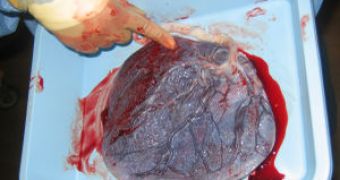A new organism develops inside the woman's womb due to the placenta, a special organ for delivering food and oxygen from the mother to the fetus. A new research made at the Stanford University School of Medicine and published in the journal Genome Research has revealed the first genetic clues about the ancient origins of the placenta.
The study shows that the placenta of all mammals (humans included) evolved from a much simpler tissue, called allantois, located inside the eggshells of the reptilian ancestors (and present also in birds) that enables the embryos of these animals to get oxygen.
"The placenta is this amazing, complex structure and it's unique to mammals, but we've had no idea what its evolutionary origins are. It is the only organ to develop in adulthood and is the only one with a defined end date, making the placenta of interest to people curious about how tissues and organs develop," said senior author Dr. Julie Baker, assistant professor of genetics.
The research is also of great interest from the medical point of view, as placenta is involved in the movement of chemicals from the mother to the unborn baby, with health effects that can persist into adulthood. Placenta may be also involved in triggering the maternal labor and pre-eclampsia (womb convulsions that can cause spontaneous abortions), a main cause of premature births.
To see how the placenta evolved, the research team focused on which genes are active in placental cells throughout pregnancy in mice. It appeared that the placenta has two distinct developmental stages.
In the first stage, lasting through mid-gestation, the main active genes in the placental cells are those that mammals have in common with birds and reptiles, and involved in the development of the allantois. Thus, the placenta evolved initially as a repurposed allantois, about 120 million years ago (first mammals appeared earlier, but they laid eggs, like the modern day platypus and echidna).
In the second stage, cells of the mammalian placenta activate a new set of species-specific genes (marsupials seem to have stopped to the first stage, giving birth to small, undeveloped babies). Mice have their own set of genes, and humans have human-specific genes.
"It makes sense that each animal would need a different set of genes. A pregnant orca has different needs than a mouse and so they had to come up with different hormonal solutions to solve their problems," said Baker, pointing to the difference between a elephant's placenta feeding a single fetus for 660 days, while a female mouse gestates about 12 offspring for 20 days.
"These findings are particularly interesting given that cloned mice are at high risk of dying soon after the placenta's genetic transition takes place. There's obviously a huge regulatory change that takes place," said Baker.
With all the significant shift occurring in the placenta, the tissue doesn't change its look.

 14 DAY TRIAL //
14 DAY TRIAL //